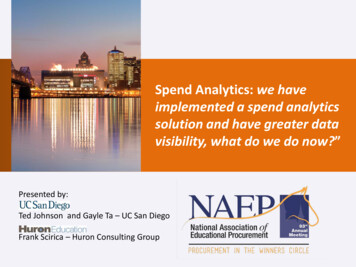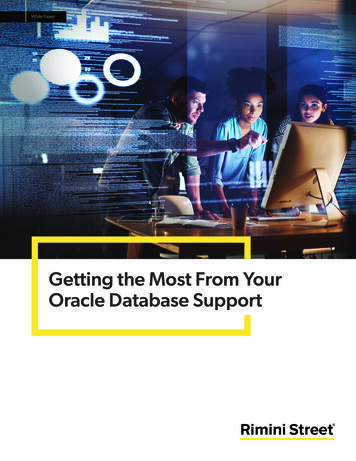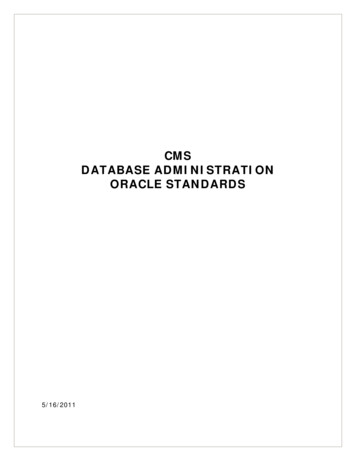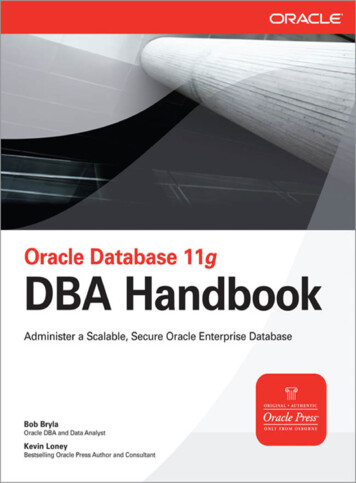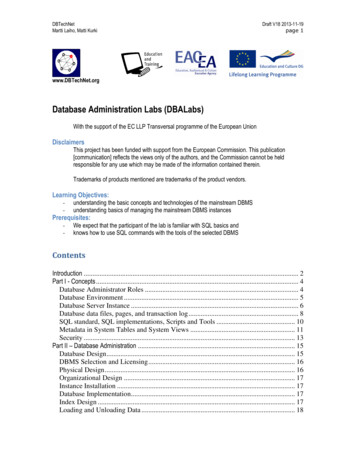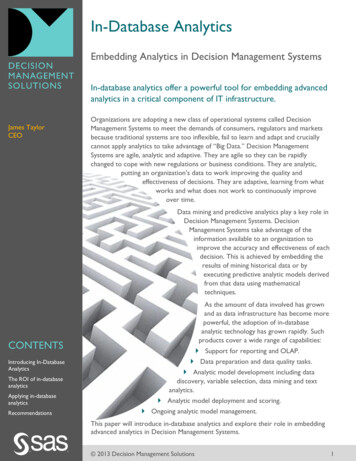
Transcription
In-Database AnalyticsEmbedding Analytics in Decision Management SystemsIn-database analytics offer a powerful tool for embedding advancedanalytics in a critical component of IT infrastructure.James TaylorCEOOrganizations are adopting a new class of operational systems called DecisionManagement Systems to meet the demands of consumers, regulators and marketsbecause traditional systems are too inflexible, fail to learn and adapt and cruciallycannot apply analytics to take advantage of “Big Data.” Decision ManagementSystems are agile, analytic and adaptive. They are agile so they can be rapidlychanged to cope with new regulations or business conditions. They are analytic,putting an organization’s data to work improving the quality andeffectiveness of decisions. They are adaptive, learning from whatworks and what does not work to continuously improveover time.Data mining and predictive analytics play a key role inDecision Management Systems. DecisionManagement Systems take advantage of theinformation available to an organization toimprove the accuracy and effectiveness of eachdecision. This is achieved by embedding theresults of mining historical data or byexecuting predictive analytic models derivedfrom that data using mathematicaltechniques.As the amount of data involved has grownand as data infrastructure has become morepowerful, the adoption of in-databaseanalytic technology has grown rapidly. Suchproducts cover a wide range of capabilities:CONTENTSIntroducing In-DatabaseAnalyticsThe ROI of in-databaseanalyticsApplying in-databaseanalyticsRecommendationsSponsored By Support for reporting and OLAP. Data preparation and data quality tasks. Analytic model development including datadiscovery, variable selection, data mining and textanalytics. Analytic model deployment and scoring. Ongoing analytic model management.This paper will introduce in-database analytics and explore their role in embeddingadvanced analytics in Decision Management Systems. 2013 Decision Management Solutions1
In-Database AnalyticsIntroducing In-Database AnalyticsIn-database analytics can mean exactly that—analytic capabilities embedded in arelational or columnar database. The phrase is also used to describe analyticcapabilities embedded in data warehouse software, in data appliances andincreasingly in Hadoop clusters.Defining in-databaseIn-database analytic capability is delivered as a set of libraries, User DefinedFunctions, that deliver analytic or data mining functions such that they can: Access the data in the database, data warehouse, appliance or Hadoop filesystem in situ, without needing to extract it to some interim format. Directly use the memory, parallel processing capabilities and loadbalancing/processor management of the data infrastructure. Be accessed both from specialist analytic tools (for model creation or dataquality tasks for instance) and from operational systems.In-database analytic capabilities are specific to a particular database, data warehouse,data appliance or Hadoop distribution. Many vendors offer support for multiple datainfrastructure platforms. Some capabilities are provided by the data infrastructurevendors, some by specialty analytic vendors, and some through partnershipsbetween analytic and data infrastructure vendors.When it comes to supporting Decision Management Systems, the core capabilitiesto look for today in an in-database analytic product are: In-database data preparation and quality. In-database modeling. In-database model deployment.It is not that in-database analytic support for reporting or OLAP is unimportant,only that it is not the focus for Decision Management Systems. It should be notedthat the same ROI often applies when using in-database analytics to improvemanual decision making.In the future, more extensive support for analytic model management and forwrapping analytics in business rules for in-database decision-making will becomeincreasingly important. 2013 Decision Management Solutions2
In-Database AnalyticsIn-database data preparation and qualityData preparation, integration and cleaning often consumes 60-70% of the time andeffort on an analytic project. In a traditional approach, data is extracted from thedata infrastructure in which it is stored, processed through various preparationsteps and then presented to the analytic modeling algorithms that need it.With in-database capabilities, however, these steps all execute in-database. Thismeans the original data is not extracted from the database but is processed in situ.The resulting cleaned and transformed data may be stored in the data infrastructureor passed out to a predictive analytic workbench for further processing. The net isthat data required for analytic modeling is transformed in-database.SQL Push Back is a common feature of analytic model tools. This involvesgenerating complex SQL to handle a set of data extraction and preparation stepsin a model workflow so that they can be performed in a single query. While this issimilar to the use of an in-database analytic engine to handle data preparation andquality this is not the focus of this paper due to its more limited scope.Sometimes in-database data preparation and quality capabilities support only singlefunction calls and job/script/workflow management is handled outside the database.More complete offerings allow more whole scripts/jobs to be executed in-database.In-database model developmentIn-database model development allows predictive analytic models to be developedusing algorithms embedded in the data infrastructure. These algorithms access tablesand views directly to get the data they need, process the data using the datainfrastructure’s processing capabilities, and create a predictive analytic model. Thismodel may be stored in the data infrastructure for in-database scoring or it may bepassed out for use elsewhere.These capabilities may be integrated with an external predictive analytic workbenchso that they can be called as part of a modeling exercise. Some in-database modelingcapabilities support the same wide range of modeling techniques as a predictiveanalytic workbench. Some support only a subset and are used by a predictiveanalytic workbench to offload some of the work of building predictive analyticmodels to the data infrastructure—essentially processing some of the steps definedin the workflow in-database. 2013 Decision Management Solutions3
In-Database AnalyticsIn-database model deployment and scoringIn-database model deployment and scoring infrastructure takes models developedusing some combination of in-database modeling infrastructure and a predictiveanalytic workbench and executes them in an operational datastore so they areavailable to operational systems accessing that datastore. This generally involvesturning models into UDFs or stored procedures that can be called using SQL andthat take database fields as input. These functions can be used in standard SQLstatements and embedded into database views as though they are database columns,making the scores available widely. Another approach is to install an EmbeddedProcess and run inside the database to read and write data from the database. Theadvantage of using the Embedded Process is that a single function or a storedprocedure is used instead of multiple, user-defined functions.Figure 1: In-Database Analytics in Context 2013 Decision Management Solutions4
In-Database AnalyticsThe ROI of in-database analyticsAs with any product, a return on investment can come from increased revenue ordecreased costs. Predictive analytics often add top-line revenue by boosting sales ordriving fraud out. These kinds of returns are due to the use of predictive analytics ingeneral rather than the use of in-database analytics specifically. Nevertheless indatabase analytics offer an ROI both by increasing value (though speed to market,improved accuracy and increased accessibility) and by decreasing costs.Speed to MarketThe key to deriving ROI from in-database analytics is a dramatic increase in speed tomarket. Using in-database analytics allows for value from analytics sooner. Thisincrease in speed delivers analytic models more quickly by taking advantage ofseveral characteristics of in-database analytics technology: Streamlining data preparation and other preparation activities though theelimination of data movement and replication. Executing analytic algorithms in the same memory space and using the highperformance hardware common in data infrastructure. Massive parallelism of analytic algorithms so they can take advantage of MPParchitectures to develop models across multiple nodes in the data infrastructure. Improved handling of very large datasets and large numbers of variables throughexecution of algorithms inside the database. Eliminating the need to re-code analytic models so they can be deployed.This can result in a 10-100x overall reduction in time from when a team starts towhen decisions are being made more analytically in a decision management system.Improved AccuracyPredictive analytic models developed using in-database analytic technology might bemore accurate than those developed more traditionally: A faster cycle time can mean that more approaches can be considered, moreiterations performed resulting in a superior approach. The ability to access data directly and not have to move it around can eliminatethe need for sampling while simultaneously reducing the likelihood of errorsbeing introduced in manual extraction/cleaning steps. Using the “main” data store rather than an analytical data mart may mean a moreup to date and large dataset is available. Increased model development performance can be leveraged to develop moremodels using more algorithms for use in a more precise ensemble model. 2013 Decision Management Solutions5
In-Database AnalyticsIncreased AccessibilityLastly it is likely that the resulting analytics will be more accessible and so morelikely to be used in more places, increasing their reach. This is particularly true inorganizations where development tools are not analytically aware. For instancewhile most modern business rules management systems can easily execute ananalytic model (and many import PMML), a system based on COBOL cannot easilybe changed to execute a predictive analytic model. If the model is made available inthe database, however, it may be possible to use it with far less change to the code.The use of in-database analytics is a perfect vehicle to bring analytic and IT teamstogether. Too often the analytic and IT/data architecture teams can be at odds.The use of in-database analytics can bring the two groups onto the same side,using the approach to avoid data replication, improve governance and makeanalytic scores broadly available through the IT infrastructure.Lower costThe primary cost reduction is from less hardware and improved utilization. Becausein-database analytic approaches reuse database appliances and other datainfrastructure, less hardware has to be bought. At the margins there may also bereduced costs resulting from moving less data, though probably only in extremecases or when data movement is billed for directly by an infrastructure provider. Asdata grows, the case for in-databases becomes stronger because the penalty formoving data out of the database becomes greater. Similarly the rapid growth in datavolumes means that any analytical server must grow as fast as the database serverdoes if analytic tasks are not performed in-database.Many databases and data warehouse platforms have extensive support forintegrating external data and making this data available through standard SQL. Assuch it is available to in-database analytic capabilities. Especially when such anapproach is used to bring in data stored on Hadoop or commodity hardware it maylower the cost to store the increasingly large volumes of data being collected. Within-database analytics all this data is available to algorithms executing in the database.Costs may also be lowered through better governance as analytic models aremanaged like metadata in a typical in-database analytic infrastructure. This mayinvolve less cost and less risk than traditional approaches that involve widely spreadscripts and workflows.It should be noted that data infrastructure, especially high performance and moreexpensive varieties, tends to be very heavily utilized. Therefore, proper sizing ofrequired capacity to take full advantage of in-database processing must be takeninto consideration beforehand. 2013 Decision Management Solutions6
In-Database AnalyticsApplying in-database analyticsWhen developing analytics for use in a Decision Management System there’sgenerally a simple sequence of steps: The team discovers and models the decisions that are to be supported. Thisidentifies potential uses of analytics and establishes a decision-making context. The analytics group then proceeds through an interactive discovery processinvolving multiple model attempts, testing, and refinement until they have asuitable analytic model. This model is then deployed into a complete Decision Management Systemwhere it may be combined with business rules to make decisions. How well the decision is working is measured over time and the performance ofthe analytic models involved, changes in data distribution and more aremonitored. Based on this analysis regular updates of the model may be needed. Over time changing business requirements or large shifts in performance willrequire the team to go back and repeat its original interactive discovery effort.Over time this becomes a continuous sequence of steps, developing, embedding andimproving predictive analytic models.In-database analytic technologies add value throughout this sequence. Interactive modeling is faster thanks to more rapid turnaround of candidatemodels. Sampling is no longer required and models use 100% of the data. The preparation of data for modeling
Data mining and predictive analytics play a key role in Decision Management Systems. Decision Management Systems take advantage of the information available to an organization to improve the accuracy and effectiveness of each decision. This is achieved by embedding the results of mining historical data or by executing predictive analytic models derived from that data using mathematical .

